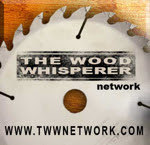There isn't much to report at this stage. We got back home from my brother-in-law's house in upstate New York on Friday afternoon, at about 3:45 pm. This was a little later than I had originally anticipated, but only by about 15 minutes. After unpacking & returning Thanksgiving phone calls we'd received while we were away, it was too late to do anything, so we had dinner.
I didn't get into the shop on Saturday to work on the cabinet, either. Saturday was put-up-the-outdoor-Christmas-lights-display day. We're not one of those houses that goes all out & puts a few hundred thousand lights on the house, but we do have two blow-ups and some lights that we put on the bushes in front of the house. This year, we added some twinkling candy cane lawn stakes and wrapped two of our new porch posts with 3" red ribbon to make them look like candy canes, or barber poles, depending on your perspective.
I had to make a couple of trips to the hardware store for the lights, and I didn't get everything up yesterday. So after church this morning, after we got home, I spent some time finishing off the lights.
I did get into the shop this evening to make a cradle for the cabinets. "A what?" you're saying. Let me explain.
As you can see from the pictures I've posted and from the plans, this cabinet is not rectangular. It's shaped more like home plate than a rectangle. I'm going to need to lie this thing down flat on its back for a couple of operations while I'm applying the mitered moldings, and maybe even while I'm finishing it. The back of the two cabinets are only about 4" wide, while the widest part, near the front, is about 33" wide. So how can I keep this thing steady while I have it lying on its back? The last thing I want is for it to topple over & get damaged.

The answer is to take 4 of the triangular cutoffs I have from making the top & bottom shelves, along with some other plywood cut offs, and make a cradle.
The photo at the left shows what I made. I am going to sand the angled edges & apply some weather stripping to help cushion the cabinet that is lying in the cradle. It will help compensate for angles that aren't exactly identical between the back of the cabinet & the pieces I used, plus it will prevent the unit from sliding in the cradle.

In a comment to one of my earlier postings, Neil from Furnitology Productions asked me what the back of the unit looked like. The picture at right is a long delayed response to that comment.
If you look closely, you can see some damage to the back that occurred yesterday. After I had glued this up, the backs wouldn't stay in proper alignment with each other. In hind sight, this was probably because I'd run out of brads in my nailer & didn't realize it.
I ended up grabbing two of the triangular blocks I made for gluing up the birds mouth joints I'd made & applying them to the back with hot melt glue, then placing a 12" K-body across the blocks. This closed everything up, and I left the clamp in place when I put the cabinet back into the unheated shop the morning we left for upstate New York.
So last night, I was in the garage at one point looking for something I needed for the lights, and I saw that clamp hanging off the back. So I removed it, returned it to its home in my clamp rack, and then knocked the blocks off with my fist. Apparently, either the glue set really well, or the cold affected the bond, because two small pieces of one of the back panels came off with that block. Something similar happened on the other back.
I'm not too worried about this damage, though, since they are parts that will never be seen except for when the dining room gets painted once in every few years.
It doesn't look like I'll be getting much time to work on it next weekend, either, at this point. We have a function to go to next Saturday, and my daughter & I will be attending a Christmas ornament turning class on Sunday. We'll see what I can squeeze in.
Anybody have any recommendations on a good radiant heater? I gotta warm that garage up soon.























